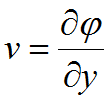|
<< Click to Display Table of Contents >> Electrostatics |
  
|
|
<< Click to Display Table of Contents >> Electrostatics |
  
|
Perhaps the most important of all partial differential equations is the simple form
(1.1) ![]()
It is encountered in virtually all branches of science and engineering, and describes the diffusion of a quantity ![]() with diffusivity k and volume source q. With k=1 it is referred to as Poisson’s equation,
with diffusivity k and volume source q. With k=1 it is referred to as Poisson’s equation, ![]() . With k=1 and q=0, it is referred to as Laplace’s equation,
. With k=1 and q=0, it is referred to as Laplace’s equation, ![]() .
.
If ![]() is electric potential, k is permittivity and q is charge density, then (1.1) is the electrostatic field equation.
is electric potential, k is permittivity and q is charge density, then (1.1) is the electrostatic field equation.
If ![]() is temperature, k is thermal conductivity and q is heat source, then (1.1) is the heat equation.
is temperature, k is thermal conductivity and q is heat source, then (1.1) is the heat equation.
If we identify derivatives of ![]() with fluid velocities,
with fluid velocities,
![]() ,
, 
then (1.1) is the potential flow equation.
In most cases, we can identify ![]() with the flux of some quantity such as heat, mass or a chemical. (1.1) then says that the variation of the rate of transfer of the relevant quantity is equal to the local source (or sink) of the quantity.
with the flux of some quantity such as heat, mass or a chemical. (1.1) then says that the variation of the rate of transfer of the relevant quantity is equal to the local source (or sink) of the quantity.
If we integrate the divergence term by parts (or equivalently, apply the divergence theorem), we get
(1.2) ![]()
That is, the total interior source is equal to the net flow across the outer boundary.
In a FlexPDE script, the equation (1.1) is represented simply as
Div(k*grad(phi)) + q = 0
The boundary flow ![]() is represented in FlexPDE by the Natural boundary condition,
is represented in FlexPDE by the Natural boundary condition,
Natural(phi) = <boundary flux>
The simplest form of the natural boundary condition is the insulating or “no flow“ boundary,
Natural(phi) = 0.